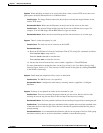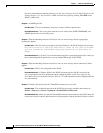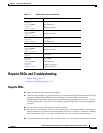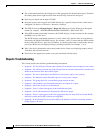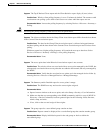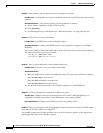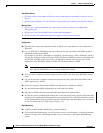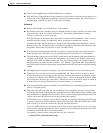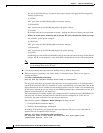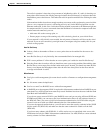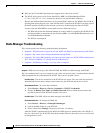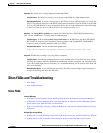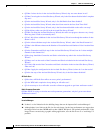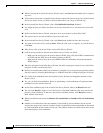
1-37
FAQ and Troubleshooting Guide for the CiscoWorks Wireless LAN Solution Engine
OL-8376-01
Chapter 1 FAQs and Troubleshooting
Radio Manager FAQs and Troubleshooting
Q.
What is the throughput impact if Radio Monitoring is enabled?
A.
Each AP scans all supported non-serving channels every 90 seconds. Each non-serving channel scan
lasts for 20 to 30ms depending on radio type. Because of the short duration, the overall impact to
the throughput should be less than 1% of the total bandwidth.
Self Healing
Q.
How do “Hot Standby” and “Self-Healing” work together?
A.
Hot Standby allows the customer to keep a redundant standby AP set for a primary AP. Then, if the
primary AP goes down, the standby will take over—presumably, with the same or similar
settings—to allow for no loss in coverage.
With Self Healing, the WLSE monitors the wireless network and if it determines a radio is down, it
modifies the power settings of neighboring APs in an attempt to maintain the coverage.
If both Hot Standby and Self Healing are deployed, then Hot Standby takes precedence over Self
Healing. In this case, Self Healing does not modify the neighboring APs unless the standby becomes
the primary AP and that AP goes down as well (a double failure).
Q.
In a centralized deployment where WLSE is located in a central location and wireless network is
being managed across the WAN, how does Self Healing behave when there is a WAN failure?
A.
The Self Healing feature runs on the WLSE, which means that the downed radio determination is
evaluated on the WLSE. The data for this determination is provided to the WLSE over the wired
network via the WDS and SWAN architecture. The power setting changes are initiated from the
WLSE and deployed over the wired network as well. If there is a prolonged WAN failure between
the WLSE and the wireless network under management, the WLSE cannot provide the Self Healing
feature.
Q.
The suggested new settings are confusing—why does Self Healing decrease the transmit power?
A.
Transmit power is not always increased on neighboring APs. When a radio is detected as down,
WLSE computes the best coverage possible given the available radios and current channel settings.
In response to a downed radio, WLSE only changes power—it does not change the channels. Given
these constraints, the power for some radios is turned down while the power for others is turned up
to ensure the best coverage. While this may not seem intuitive, it is expected.
Q.
After the administrator replaces the failed AP, will WLSE detect it and change the power of that AP
back to its original power?
A.
When the failed AP is up again, the next self-healing event recalculates the power setting for the
surrounding APs based on the latest radio measurement data (if Radio Monitoring is enabled, radio
measurement data is updated every 90 seconds). The new power setting might not be the same as the
original one because WLSE does not save the original power settings.
WLSE assumes you are using it for your initial setup and site planning, and therefore Self Healing
is merely a rerun of the initial calculations minus the downed radio. When WLSE finds that a failed
radio is back up, it reruns the calculations, this time including the radio.
If you use WLSE initially, the calculations will yield the same or equivalent results. If you set your
power settings manually, then after the radio is detected as down and then back up, the results of the
calculations could differ from your manual settings.
For example, assume you have a network with four APs {A,B,C,D}.
–
When WLSE is used for initial setup:



